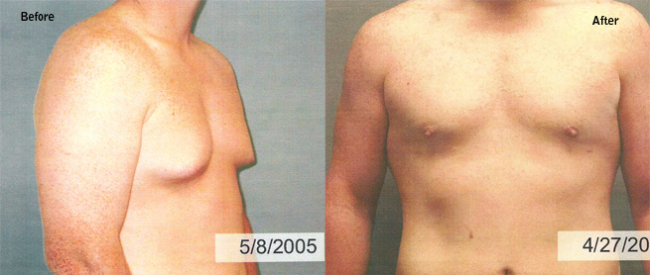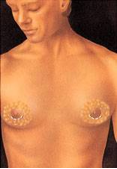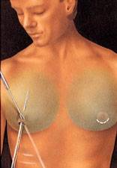Male Breast Reduction (Gynecomastia)

Enlarged male breasts, also known as Gynecomastia, can cause emotional discomfort and impair your self-confidence. This affects an estimated 40 to 60 percent of men. Though certain drugs and medical problems have been linked with male breast over-development, there is no known cause in the vast majority of cases. It may affect only one breast or both.
Gynecomastia is characterized by:
- Excess localized fat
- Excess glandular tissue development
- A combination of both excess fat and glandular tissue
Gynecomastia can be surgically treated by removing excess fat, glandular tissue, and/or skin. The result is a better proportioned more masculine-contoured upper body and the freedom and self-confidence to lead an active life.
The Best Candidates for Gynecomastia Correction
Surgery to correct gynecomastia can be performed on healthy, emotionally stable men of any age. The best candidates for surgery have firm, elastic skin that will reshape to the body’s new contours.
Surgery may be discouraged for obese men, or for overweight men who have not first attempted to correct the problem with exercise or weight loss. Also, individuals who drink alcoholic beverages in excess or smoke marijuana are usually not considered good candidates for surgery. These drugs, along with anabolic steroids, may cause gynecomastia. Therefore, patients are first directed to stop the use of these drugs to see if the breast fullness will diminish before surgery is considered an option.
All Surgery Carries Some Uncertainty and Risk
When male breast reduction surgery is performed by a qualified plastic surgeon, complications are infrequent and usually minor. Nevertheless, as with any surgery, there are risks. These include infection, skin injury, excessive bleeding, adverse reaction to anesthesia, and excessive fluid loss or accumulation. The procedure may also result in noticeable scars, permanent pigment changes in the breast area, or slightly mismatched breasts or nipples. If asymmetry is significant, a second procedure may be performed to remove additional tissue.
The temporary effects of breast reduction include loss of breast sensation, numbness, which may last up to 1 year.
Planning Your Surgery
The initial consultation with Dr. Legere is very important. She will need a complete medical history so check your own records ahead of time and be ready to provide this information. First, she will examine your breasts and check for causes of the gynecomastia, such as impaired liver function, use of estrogen-containing medications, or anabolic steroids. If a medical problem is the suspected cause, you’ll be referred to an appropriate specialist.
Dr. Legere may, in extreme cases, also recommend a mammogram, or breast x-ray. This will not only rule out the very small possibility of breast cancer, but will reveal the breast’s composition. Once she knows how much fat and glandular tissue is contained within the breasts, she can choose a surgical approach to best suit your needs.
Don’t hesitate to ask her any questions you may have during your initial consultation — including your concerns about the recommended treatment or the costs involved. Treatment of gynecomastia may be covered by medical insurance — but policies vary greatly. Check your policy or call your carrier to be sure. If you are covered, make certain you get written pre-authorization for the treatment recommended by Dr. Legere.
Preparing for Your Surgery
Dr. Legere will give you specific instructions on how to prepare for surgery, including guidelines on eating, drinking, and taking certain vitamins and medications.
Smokers should plan to stop smoking for a minimum of one to two weeks before surgery and during recovery. Smoking decreases circulation and interferes with proper healing. Therefore, it is essential to follow all Dr. Legere’s instructions.
The Surgery
If excess glandular tissue is the primary cause of the breast enlargement, it will be excised or cut out, with a scalpel. The excision may be performed alone or in conjunction with liposuction. In a typical procedure, an incision is made in an inconspicuous location — either on the edge of the areola or in the underarm area. Working through the incision, the surgeon cuts away the excess glandular tissue, fat, and skin from around the areola and from the sides and bottom of the breast. Major reductions that involve the removal of a significant amount of tissue and skin may require larger incisions that result in more conspicuous scars. If liposuction is used to remove excess fat, the cannula is usually inserted through the existing incisions.

Glandular tissue must be cut out, usually through a small incision near the edge of the areola.
If your gynecomastia consists primarily of excess fatty tissue, your surgeon will likely use liposuction to remove the excess fat. A small incision, less than half in length, is made around the edge of the areola — the dark skin that surrounds the nipple. Or, the incision may be placed in the underarm area. A slim hollow tube called a cannula which is attached to a vacuum pump, is then inserted into the incision. Using strong, deliberate strokes, the surgeon moves the cannula through the layers beneath the skin, breaking up the fat and suctioning it out. Patients may feel a vibration or some friction during the process, but generally no pain.
In extreme cases where large amounts of fat or glandular tissue have been removed, skin may not adjust will to the new small breast contour. In these cases, excess skin may have to be removed to allow the remaining skin to firmly re-adjust to the new breast contour.

Sometimes, a small drain is inserted through a separate incision to draw off excess fluids. Once closed, the incisions are usually covered with a dressing. The chest may be wrapped to keep the skin firmly in place.
Fatty tissue can be removed by liposuction. A small, hollow tube is inserted through a tiny incision, leaving a nearly imperceptible scar.
After Your Surgery
Whether you’ve had an excision with a scalpel or liposuction, you will feel some discomfort for a few days after surgery. However, discomfort can easily be controlled with medications prescribed by Dr. Legere. In any case, you should arrange to have someone drive you home after surgery and to help you out for a day or two.
You’ll be swollen and bruised for a while — in fact, you may wonder if there’s been any improvement at all. To help reduce swelling, you’ll probably be instructed to wear an elastic pressure garment continuously for a week or two, and for a few weeks longer at night. Although the worst of the swelling will dissipate in the first few weeks, it may be three months or more before the final results of your surgery are apparent.
In the meantime, it is important to begin getting back to normal. You’ll be encouraged to begin walking around on the day of your surgery, and can return to work when you feel well enough — which could be as early as a day or two after surgery. Any stitches will generally be removed about 1-2 weeks following the procedure.
Dr. Legere may advise you to avoid sexual activity for a week or two, and heavy exercise for about three weeks. You’ll be told to stay away from any sport or job that risks a blow to the chest area for at least four weeks. In general, it will take about a month before you’re back to all your normal activities.
You should also avoid exposing the resulting scars to the sun for at least six months. Sunlight can permanently affect the skin’s pigmentation, causing the scar to turn dark. If sun exposure is unavoidable, use a strong sunblock.
Your New Look

Gynecomastia surgery can enhance appearance and self-confidence, but it won’t necessarily change your looks to match your ideal. Before you decide to have surgery, think carefully about your expectations and discuss them frankly with Dr. Legere.
The results of the procedure are significant and permanent. If your expectations are realistic, chances are good that you’ll be very satisfied with your new look.
(Following surgery for gynecomastia, the patient has a more masculine chest contour.)







